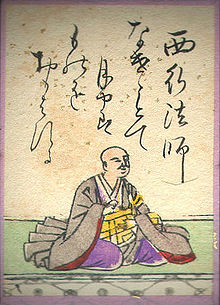- Saigyō
-
Saigyō (jap. 西行; * 1118 in Kyōto; † 1190), eigentlich: Satō Norikiyo (佐藤 義清), war ein japanischer Poet.
Inhaltsverzeichnis
Leben
Er wuchs in einem wohlhabenden Elternhaus auf. Da die Familie oft umzog, lernte er große Teile Japans kennen. Er begann eine Ausbildung zum Offizier der kaiserlichen Garde, brach diese 1140 ab und wurde Mönch (法師, hōshi) der buddhistischen Shingon-shū. Im Jahre 1180 blieb er in der Provinz Ise, wo er viele Schüler hatte.[1]
Stil
Saigyō war begeistert von der Schönheit der Natur, dies spiegelt sich auch in seinen Werken wider. Er verwendete viele Verben.
Literatur
- Saigyō: Mirror for the Moon: A Selection of Poems by Saigyō (1118–1190), translated by William R. LaFleur, New Directions 1978
- Saigyō: Poems of a Mountain Home, Columbia Univ Pr; 1992, ISBN 0-231-07493-X
- More Love Poems (101–200), Oriental Book Store, 1981, ISBN 0-686-37537-8
- As a Love Poet: One Hundred More Selections, Oriental Book Store, 1981, ISBN 0-686-37540-8
Weblinks
Einzelnachweise
- ↑ Saigyo hoshi in: Microsoft Encarta

Japanischer Name: Wie in Japan üblich, steht in diesem Artikel der Familienname vor dem Vornamen. Somit ist Satō der Familienname, Norikiyo der Vorname.
Wikimedia Foundation.

